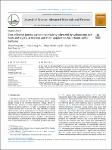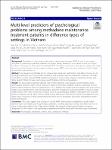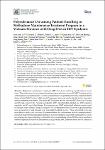Kết quả tìm kiếm từ 1 đến 19 trong 19 kết quả
Breathing is vital to life. Therefore, the real-time monitoring of a patient′s breathing pattern is crucial to respiratory rehabilitation therapies, such as magnetic resonance exams for respiratory-triggered imaging, chronic pulmonary disease treatment, a |
This study aims to develop the models of emission and fuel consumption during idling of motorcycles (MCs) in Hanoi, including the unsteady and steady idling stages. Five MC models commonly used in Hanoi were selected to measure the instantaneous emission and fuel consumption rates under the controlled conditions at the laboratory conditions. The instantaneous emission and fuel consumption models during idling were developed for the test MCs in the unsteady idling stage. The R2 of obtained models are higher than 0.9. The average emission and fuel consumption rates in the steady idling stages were determined. The average idling emissions of pollutants CO, CO2, HC and NOx were 60.9, 534.... |
The present work reports efficient electrochemical nanosensors for the sensitive monitoring of 4-nitrophenol (4-NP) in tomato samples using various biosynthesized silver nanoparticles (bio-AgNPs). Three different bio-AgNP types were synthesized using natural plant extracts, including green tea (GT) leaf, grapefruit peel (GP), and mangosteen peel (MP), aiming to investigate their effects on the formation of bio-AgNPs, as well as the analytical performance of 4-NP. Based on the obtained results, it was found that the phytochemical content in various plant extracts directly influenced the physicochemical parameters of the created bio-AgNPs, such as particle size, crystallinity, and distr... |
Zinc Ferrite (ZnFe2O4, ZFO) nanoparticles (NPs) as a multi-sensing material are successfully synthesised via a hydrothermal method and a following annealing treatment. The as-prepared ZFO-NPs were applied in electrochemical and mass-type sensors by depositing NPs directly on the screen-printed electrode (SPE) and the active electrode of a quartz crystal microbalance (QCM), respectively. The obtained results show the ZFO-NPs possessed excellent detection performance to sulphur dioxide (SO2) in the range of 2.5–20 ppm at room temperature. QCM sensor coated with ZFO-NPs showed a high response, good repeatability, as well as short-response time. Moreover, the modified-SPE with ZFO-NPs sen... |
The sensing material plays a very important role in determining the sensing properties of a gas sensor. In order to synthesise the sensing material, the precursors have a large effect on the properties of the sensing material. In this study, three types of γ-Fe2O3 nanoparticles were prepared with different ferric ion concentrations of [Fe3+] and [Fe2+] as precursors, by a typical facile chemical precipitation process and a following annealing treatment. A mass-type gas sensor was fabricated by using a quartz crystal microbalance (QCM) coated with various γ-Fe2O3 nanoparticles. The morphology, crystallisation, and gas adsorption characteristics of the γ-Fe2O3 nanoparticles were investi... |
Manganese ferrite (MnFe2O4) nanoparticles were synthesized through a coprecipitation method using manganese (II) chloride tetrahydrate (MnCl2·4H2O) and ferric chloride hexahydrate (FeCl3·6H2O) as precursors. The scanning electron microscopy images showed that the as-synthesized particles were granular and about 20 nm. The X-ray diffraction patterns revealed that the manganese ferrite phase was completely decomposed into ferric oxide (Fe2O3) and manganese (III) oxide (Mn2O3) after annealing above 800°C in air. In contrast, its crystalline quality significantly improved when it was annealed in argon. By using the vibrating-sample magnetometry technique, it was demonstrated that the satu... |
The rational design of nanomaterials for electrochemical nanosensors from the perspective of structure–property–performance relationships is a key factor in improving the analytical performance toward residual antibiotics in food. We have investigated the effects of the crystalline phase and copper loading amount on the detection performance of Cu–MoS2 nanocomposite-based electrochemical sensors for the antibiotic chloramphenicol (CAP). The phase composition and copper loading amount on the MoS2 nanosheets can be controlled using a facile electrochemical method. Cu and Cu2O nanoparticle-based electrochemical sensors showed a higher CAP electrochemical sensing performance as compared t... |
An efficient colorimetric probe based on surface-functionalized silver nanoparticles (AgNPs) was prepared for sensitive thiram pesticide detection in water samples. The influence of various surface capping agents including polyhexamethylene biguanide hydr |
Multifunctional nanocomposites have received great attention for years; electron transfer (ET) is considered as an explanatory mechanism for enhancement of performance of these nanostructures. The existence of this ET process has been proved in many studies using either experimental or computational approaches. In this study, a ternary nanocomposite system of Ag/TiO2/GO was prepared to evaluate the performance enhancement in two experimental models: a physical model (i.e., surface-enhanced Raman scattering (SERS) sensor) and a chemical one (i.e., catalytic reduction reaction). The metal/semiconductor heterojunction between Ag and TiO2, as well as Ti-O-C bonds, has allowed plasmonic ho... |
In this work, an eco-friendly approach for the synthesis of biogenic silver nanoparticles (bio-AgNPs) using botanical extracts in combination with an electrochemical process was carried out. We employed three types of plant extracts, including green tea leaf (GTE), grapefruit peel (GP), and mangosteen peel (MP) extracts to successfully synthesize the bio-AgNPs and optimized the experimental conditions aiming to get the highest synthetic yield. The formation of bio-AgNPs was monitored by UV-Vis spectroscopy via a surface plasmon resonance (SPR) band at about 420–430 nm. Transmission electron microscope (TEM) showed their spherical shape with the size range within 23–55 nm. While X-ray ... |
This study reports a scalable green electrochemical synthesis of novel biogenic silver nanoparticles colloid (biogenic AgNPs) in large scale up to 5 liters using the bulk silver bar and the green tea leaves (Camellia sinensis) extract (GTE) as reducing ag |
For mitigating environmental pollution caused by excess usage of urea fertilizer, this paper reports a new fertilizer formulation, based on urea incorporating chitosan (CS) and poly (vinyl alcohol) (PVA) blend, for the slow release of urea. The urea/CS/PVA formulations were prepared by cross-linking CS and PVA blend in the presence of urea with glutaraldehyde as a cross-linker. The results indicated an interaction between urea and the functional groups of CS and PVA through hydrogen bonding, which has significant effects on the thermal properties of urea/CS/PVA formulation. The surface morphology of urea/CS/PVA formulations showed that the quantity of urea crystals anchored on the sur... |
An electrochemical approach has been used for green synthesis of gold and silver nanoparticles (e-AuNPs and e-AgNPs) with high levels of purity and scalability. The electrochemically synthesized noble-metal nanoparticles were characterized by ultraviolet–visible (UV–Vis) spectroscopy and scanning electron microscopy (SEM), confirming the formation of spherical e-AuNPs and e-AgNPs with average size of 19 nm and 24 nm, respectively. These green nanoparticles were deposited on aluminum substrates using the drop-drying method for surface-enhanced Raman scattering (SERS)-based detection of Methylene Blue (MB) within the ranges from 10−5 M to 10−8 M and 10−7 M to 10−10 M, respectively. The ... |
Functional two-dimensional (2D) structured nanomaterials, such as, graphene oxide (GO) and molybdenum disulfide (MoS2), exhibit many advantages, including large surface areas and excellent electronic/mechanical/catalytic properties, and have shown to be s |
Showing results [1 - 19] / 19
Breathing is vital to life. Therefore, the real-time monitoring of a patient′s breathing pattern is crucial to respiratory rehabilitation therapies, such as magnetic resonance exams for respiratory-triggered imaging, chronic pulmonary disease treatment, a |
This study aims to develop the models of emission and fuel consumption during idling of motorcycles (MCs) in Hanoi, including the unsteady and steady idling stages. Five MC models commonly used in Hanoi were selected to measure the instantaneous emission and fuel consumption rates under the controlled conditions at the laboratory conditions. The instantaneous emission and fuel consumption models during idling were developed for the test MCs in the unsteady idling stage. The R2 of obtained models are higher than 0.9. The average emission and fuel consumption rates in the steady idling stages were determined. The average idling emissions of pollutants CO, CO2, HC and NOx were 60.9, 534.... |
The present work reports efficient electrochemical nanosensors for the sensitive monitoring of 4-nitrophenol (4-NP) in tomato samples using various biosynthesized silver nanoparticles (bio-AgNPs). Three different bio-AgNP types were synthesized using natural plant extracts, including green tea (GT) leaf, grapefruit peel (GP), and mangosteen peel (MP), aiming to investigate their effects on the formation of bio-AgNPs, as well as the analytical performance of 4-NP. Based on the obtained results, it was found that the phytochemical content in various plant extracts directly influenced the physicochemical parameters of the created bio-AgNPs, such as particle size, crystallinity, and distr... |
Zinc Ferrite (ZnFe2O4, ZFO) nanoparticles (NPs) as a multi-sensing material are successfully synthesised via a hydrothermal method and a following annealing treatment. The as-prepared ZFO-NPs were applied in electrochemical and mass-type sensors by depositing NPs directly on the screen-printed electrode (SPE) and the active electrode of a quartz crystal microbalance (QCM), respectively. The obtained results show the ZFO-NPs possessed excellent detection performance to sulphur dioxide (SO2) in the range of 2.5–20 ppm at room temperature. QCM sensor coated with ZFO-NPs showed a high response, good repeatability, as well as short-response time. Moreover, the modified-SPE with ZFO-NPs sen... |
The sensing material plays a very important role in determining the sensing properties of a gas sensor. In order to synthesise the sensing material, the precursors have a large effect on the properties of the sensing material. In this study, three types of γ-Fe2O3 nanoparticles were prepared with different ferric ion concentrations of [Fe3+] and [Fe2+] as precursors, by a typical facile chemical precipitation process and a following annealing treatment. A mass-type gas sensor was fabricated by using a quartz crystal microbalance (QCM) coated with various γ-Fe2O3 nanoparticles. The morphology, crystallisation, and gas adsorption characteristics of the γ-Fe2O3 nanoparticles were investi... |
Manganese ferrite (MnFe2O4) nanoparticles were synthesized through a coprecipitation method using manganese (II) chloride tetrahydrate (MnCl2·4H2O) and ferric chloride hexahydrate (FeCl3·6H2O) as precursors. The scanning electron microscopy images showed that the as-synthesized particles were granular and about 20 nm. The X-ray diffraction patterns revealed that the manganese ferrite phase was completely decomposed into ferric oxide (Fe2O3) and manganese (III) oxide (Mn2O3) after annealing above 800°C in air. In contrast, its crystalline quality significantly improved when it was annealed in argon. By using the vibrating-sample magnetometry technique, it was demonstrated that the satu... |
The rational design of nanomaterials for electrochemical nanosensors from the perspective of structure–property–performance relationships is a key factor in improving the analytical performance toward residual antibiotics in food. We have investigated the effects of the crystalline phase and copper loading amount on the detection performance of Cu–MoS2 nanocomposite-based electrochemical sensors for the antibiotic chloramphenicol (CAP). The phase composition and copper loading amount on the MoS2 nanosheets can be controlled using a facile electrochemical method. Cu and Cu2O nanoparticle-based electrochemical sensors showed a higher CAP electrochemical sensing performance as compared t... |
An efficient colorimetric probe based on surface-functionalized silver nanoparticles (AgNPs) was prepared for sensitive thiram pesticide detection in water samples. The influence of various surface capping agents including polyhexamethylene biguanide hydr |
Multifunctional nanocomposites have received great attention for years; electron transfer (ET) is considered as an explanatory mechanism for enhancement of performance of these nanostructures. The existence of this ET process has been proved in many studies using either experimental or computational approaches. In this study, a ternary nanocomposite system of Ag/TiO2/GO was prepared to evaluate the performance enhancement in two experimental models: a physical model (i.e., surface-enhanced Raman scattering (SERS) sensor) and a chemical one (i.e., catalytic reduction reaction). The metal/semiconductor heterojunction between Ag and TiO2, as well as Ti-O-C bonds, has allowed plasmonic ho... |
In this work, an eco-friendly approach for the synthesis of biogenic silver nanoparticles (bio-AgNPs) using botanical extracts in combination with an electrochemical process was carried out. We employed three types of plant extracts, including green tea leaf (GTE), grapefruit peel (GP), and mangosteen peel (MP) extracts to successfully synthesize the bio-AgNPs and optimized the experimental conditions aiming to get the highest synthetic yield. The formation of bio-AgNPs was monitored by UV-Vis spectroscopy via a surface plasmon resonance (SPR) band at about 420–430 nm. Transmission electron microscope (TEM) showed their spherical shape with the size range within 23–55 nm. While X-ray ... |
This study reports a scalable green electrochemical synthesis of novel biogenic silver nanoparticles colloid (biogenic AgNPs) in large scale up to 5 liters using the bulk silver bar and the green tea leaves (Camellia sinensis) extract (GTE) as reducing ag |
For mitigating environmental pollution caused by excess usage of urea fertilizer, this paper reports a new fertilizer formulation, based on urea incorporating chitosan (CS) and poly (vinyl alcohol) (PVA) blend, for the slow release of urea. The urea/CS/PVA formulations were prepared by cross-linking CS and PVA blend in the presence of urea with glutaraldehyde as a cross-linker. The results indicated an interaction between urea and the functional groups of CS and PVA through hydrogen bonding, which has significant effects on the thermal properties of urea/CS/PVA formulation. The surface morphology of urea/CS/PVA formulations showed that the quantity of urea crystals anchored on the sur... |
An electrochemical approach has been used for green synthesis of gold and silver nanoparticles (e-AuNPs and e-AgNPs) with high levels of purity and scalability. The electrochemically synthesized noble-metal nanoparticles were characterized by ultraviolet–visible (UV–Vis) spectroscopy and scanning electron microscopy (SEM), confirming the formation of spherical e-AuNPs and e-AgNPs with average size of 19 nm and 24 nm, respectively. These green nanoparticles were deposited on aluminum substrates using the drop-drying method for surface-enhanced Raman scattering (SERS)-based detection of Methylene Blue (MB) within the ranges from 10−5 M to 10−8 M and 10−7 M to 10−10 M, respectively. The ... |
Functional two-dimensional (2D) structured nanomaterials, such as, graphene oxide (GO) and molybdenum disulfide (MoS2), exhibit many advantages, including large surface areas and excellent electronic/mechanical/catalytic properties, and have shown to be s |








